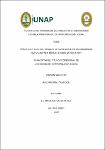| dc.contributor.advisor | Rivas Ruiz, Roxani | |
| dc.contributor.author | Tumi Dësi, Roldan Dunu | |
| dc.date.accessioned | 2022-05-27T16:05:52Z | |
| dc.date.available | 2022-05-27T16:05:52Z | |
| dc.date.issued | 2022 | |
| dc.identifier.uri | https://hdl.handle.net/20.500.12737/8040 | |
| dc.description.abstract | The present investigation entitled "Ritual practice of the application of the poison of the Acate toad in the Matsés Buenas Lomas Antigua Native Community - 2022", was developed in one of the oldest Communities of the Matsés indigenous people. Its main objective is to describe the healing ritual practice of the resin of the Acate toad in the native community of Matsés Buenas Lomas Antigua. The methodology used in this research was a qualitative approach since it sought to understand the ritual practice of the resin of the toad acate through information narrated by the Matsés actors. For ethnography or data collection technique in the field they were the following: participant observation, unstructured interview and semi-structured interview. To carry out this research, the oldest specialists between 81 and 30 years old, and also the young people between 17 and 29 years old, who administer the resin of the acate toad, were the key informants, having a total of 23 interviewees. The results of the research show that the practice of the resin of the Acate toad is a constitutive part of the formation of the Matsés person through which the generation of greater experience (grandparents and older adults), who has achieved social recognition for being great specialist in knowing how to do an activity or recognized as a worker, she transmits her ability and positive values to the young generation (boys, girls, adolescents and adults). | en_US |
| dc.description.abstract | La presente investigación titulada “Práctica ritual de la aplicación del veneno del sapo acate en la Comunidad Nativa Matsés Buenas Lomas Antigua - 2021”, se desarrolló en una de las Comunidades más antiguas del pueblo indígena matsés, ubicadas en el departamento de Loreto. Tiene como objetivo principal, describir la práctica ritual curativa de la resina del sapo acate en la comunidad nativa matsés Buenas Lomas Antigua. La metodología empleada en la investigación es de enfoque cualitativo-etnográfico ya que comprende la práctica ritual de la resina del sapo acate a través de información narrada por los actores matsés. Las técnicas de recolección de datos en el campo fueron las siguientes: observación participante, entrevista no estructurada y la entrevista semiestructurada. Los participantes de la investigación fueron los(as) especialistas: ancianos (as) de 81 años, y población joven de entre 17 a 30 años, quienes administran la resina del sapo acate y fueron los informantes claves. Obteniendo un total de 23 entrevistados. Los resultados de la investigación muestran que la práctica de la resina del sapo acate es parte constitutiva de la formación de la persona matsés a través de la cual, la generación de mayor experiencia (abuelos y adultos mayores), han logrado reconocimiento social por ser grandes especialistas por su trabajo en el saber y el hacer de una actividad especializada de su propia cotidianidad, habilidades y valores positivos que se transmiten a la generación más joven (niños, niñas, adolescentes y adultos). | es_PE |
| dc.format | application/pdf | es_PE |
| dc.language.iso | spa | es_PE |
| dc.publisher | Universidad Nacional de la Amazonía Peruana | es_PE |
| dc.rights | info:eu-repo/semantics/openAccess | * |
| dc.rights.uri | https://creativecommons.org/licenses/by/4.0/ | * |
| dc.subject | Rituales | es_PE |
| dc.subject | Sapo | es_PE |
| dc.subject | Venenos de sapos | es_PE |
| dc.subject | Poblaciones indígenas | es_PE |
| dc.title | Práctica ritual del veneno de sapo acate en la comunidad nativa Matsés Buenas Lomas Antigua 2021 | es_PE |
| dc.type | info:eu-repo/semantics/bachelorThesis | es_PE |
| thesis.degree.discipline | Antropología Social | es_PE |
| thesis.degree.grantor | Universidad Nacional de la Amazonía Peruana. Facultad de Ciencias de la Educación y Humanidades | es_PE |
| thesis.degree.name | Licenciado(a) en Antropología Social | es_PE |
| dc.subject.ocde | https://purl.org/pe-repo/ocde/ford#5.04.03 | es_PE |
| dc.subject.ocde | https://purl.org/pe-repo/ocde/ford#5.04.04 | es_PE |
| renati.author.dni | 48806228 | |
| renati.advisor.orcid | https://orcid.org/0000-0002-6382-3835 | |
| renati.advisor.dni | 5351466 | |
| renati.type | https://purl.org/pe-repo/renati/type#tesis | es_PE |
| renati.discipline | 315056 | es_PE |
| renati.level | https://purl.org/pe-repo/renati/level#tituloProfesional | es_PE |
| renati.juror | Helbert Chavez, Heinrich Albert | |
| renati.juror | Rengifo Ruiz, Roger Ernesto | |
| renati.juror | Aguilar Panduro, David Freddy | |
| dc.publisher.country | PE | es_PE |


